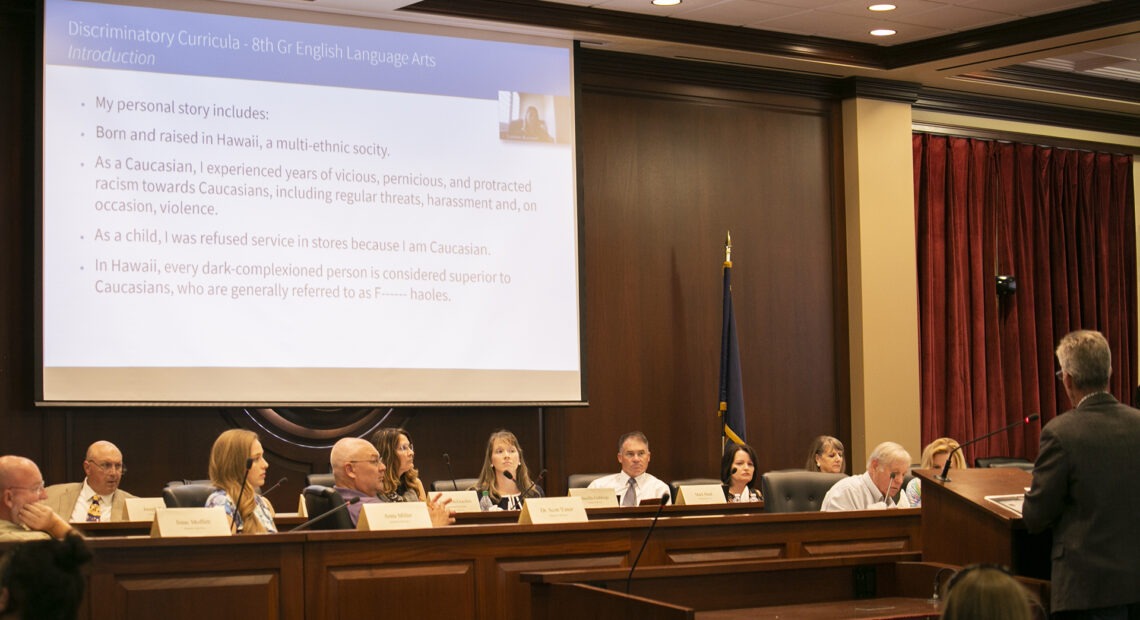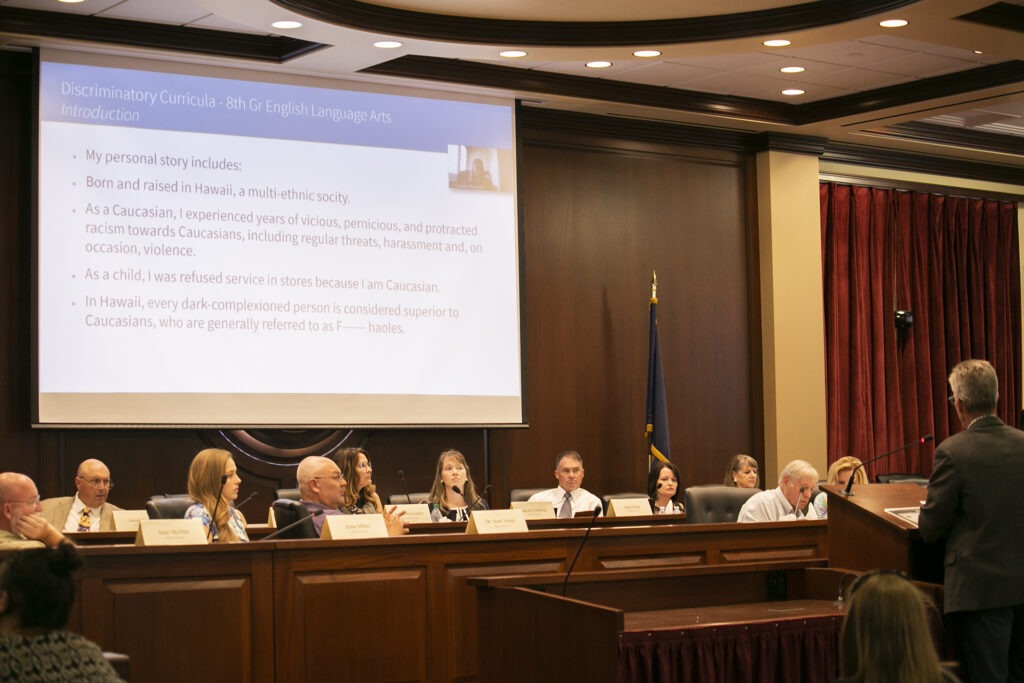
Analysis: How Critical Race Theory Turned Into A Political ‘Bogeyman’ In Idaho And Across The U.S.
BY KEVIN RICHERT / IdahoEdNews.org
Originally posted on IdahoEdNews.org on July 1, 2021
As education culture wars consumed the Statehouse this spring, the running joke was that Idaho educators were scrambling to Google to figure out what “critical race theory” is.
Things aren’t much different now. So, think of this as summer school.
What is critical race theory?
The thumbnail: It’s a framework of legal study, designed to look at how racism is engrained in society — in systems such as the law, housing policy and education, among others.
For academics, CRT provides a lens to see and account for institutional racism, Keffrelyn Brown, a professor in the Department of Curriculum and Instruction at the University of Texas, said during a recent Education Writers Association webinar. For example, Brown applies CRT when she researches elementary, middle school and high school textbooks, studying narratives on race and racial violence. Brown also notes that teachers, in K-12 as well as higher education, can apply CRT as a way of understanding how racism exists, in subjects such as history or literature.

Lt. Gov. Janice McGeachin’s task force on school indoctrination meets at the Statehouse on June 24. CREDIT: Nik Streng/Idaho Education News
Before becoming executive director of The Idaho 97 Project — a newly formed group designed to counter what it considers extremism in state politics — Mike Satz was a University of Idaho law school professor. Satz taught CRT, and he says no more than a handful of Idaho instructors taught the topic. While CRT is in an unyielding national spotlight, it’s not an isolated topic. Similar lines of critical study are applied to gender, religion and the law in general.
“This idea of critically assessing the law, it moves through all sorts of areas of law,” Satz said. “It’s all about looking at these differences, and how does the law engage with people? How do our institutions engage with people?”
CRT is an esoteric graduate school- or law school-level discipline. In other words, there’s a reason why educators talk about how CRT isn’t taught in high schools, or elsewhere in the K-12 system.
But as the CRT debate has gone national and turned bitter, a specialized field of study has become a catchall talking point. In a recent explainer story on CRT, Education Week reporter Stephen Sawchuk offered an excellent analogy from the K-12 world.
“A good parallel here is how popular ideas of the Common Core learning standards grew to encompass far more than what those standards said on paper,” Sawchuk wrote.
In Idaho, the debate over statewide Common Core standards was quickly mashed into a debate over local curriculum decisions. Catchphrases, such as Common Core and CRT, have a way of assuming lives of their own.
What isn’t critical race theory?
Let’s look at a recent story: the State Board of Education’s new proposed diversity and inclusion policy.
The policy is itself long on definitions: diversity, educational equity and inclusion. Case in point: “Inclusion is the fostering of an environment in which the inherent worth and dignity of all individuals are recognized and valued, and where individuals have equitable opportunities to be included, engaged, and accepted with a sense of belonging.”
These were controversial concepts, even before the critical race theory debate flared up. In 2019, conservative legislators pushed new Boise State University President Marlene Tromp to disavow diversity and inclusion programs on campus. (She has defended these programs.)
No surprise, then, that the State Board proposal is already drawing political fire, two months before a final vote is expected.
Ed Humphreys, a Republican gubernatorial candidate, said Gov. Brad Little’s board appointees should resign for promoting an anti-American social justice agenda. Branden Durst, courting a similar conservative GOP audience in his run for state superintendent, took his own swing at the State Board.
“Unfortunately, rather than lead on this issue and ban critical race theory, they have capitulated to liberals and have embraced it,” Durst said in a news release.
But here’s one catch: Diversity and multiculturism programs have nothing to do with CRT, Nolan Cabrera, an associate professor with the University of Arizona’s Center for the Study of Higher Education, said during the EWA’s recent webinar.
And here’s another catch: The State Board policy doesn’t mention CRT at all.
Asked to clarify his position, Durst doubled down.
“Silence is consent and by doing nothing to address the scourge of critical race theory, they are embracing it,” he said in an email Wednesday.
When definitions turn political
Shortly after the first meeting of her school indoctrination task force, Lt. Gov. Janice McGeachin asked her hand-picked group to define critical race theory.
She sent back the task force’s definitions in a June 4 email, obtained by Idaho Education News through a public records request.
Presented anonymously, the definitions are varied. Echoing the scholarly definition, a couple of task force members reasonably describe CRT as a study of institutions. According to CRT, racism is “a social construct … something embedded in legal systems and policies,” as one task force member put it.
Others took a darker and defeatist tone.
“CRT is a theory that continuously pits one race and person against another,” said one task force member. “I.e., white people are always oppressors always will be, whereas minorities are victims and always will be. Nothing that either race does will fix their standing.”
A second task force member said CRT can be used “to allocate privilege under the guise of ‘equity.’’’
A third task force member said only, “Race payback.”
McGeachin didn’t respond to a request for comment on her group’s definitions. But for critics of the task force — who accuse McGeachin of assembling a one-sided group with preconceived notions — these comments will do nothing to appease their concerns.
‘Critical race theory is the bogeyman’
“(Critical race theory is) an extremely complex subject,” Satz said this week. “When I hear these people discussing it, I’m like, ‘You don’t even know what you’re talking about.’”
One group that has been talking a lot about CRT is one of Satz’s political adversaries: the Idaho Freedom Foundation. Where Satz’s Idaho 97 project is a public policy startup, the Freedom Foundation is an established force in the Statehouse, with the support of a core of like-thinking hardline conservative lawmakers.
For instance, the Freedom Foundation convinced the 2021 Legislature to reject a $6 million-a-year federal early education grant, supported by the Trump White House and Gov. Brad Little. The Freedom Foundation argued that the early education programs would have introduced a leftist learning model that reinforced CRT’s concepts.
“Math is racial oppression and white babies are racist,” the foundation said in one email to supporters.
There is a reason why groups play the CRT card. It works. And politicians listen. Legislatures or politicians in 27 states have targeted bias, indoctrination or critical race theory, Chalkbeat reports. This includes Idaho, which passed an anti-indoctrination law that specifically addressed CRT.
What’s happening in the Idaho Statehouse is not occurring in a vacuum.
Repeating a common analogy — one that made it into a recent Time magazine cover story — the University of Arizona’s Cabrera summarized the politics succinctly last week. “Critical race theory is the bogeyman.”
Each week, Kevin Richert writes an analysis on education policy and education politics. Look for it every Thursday.















